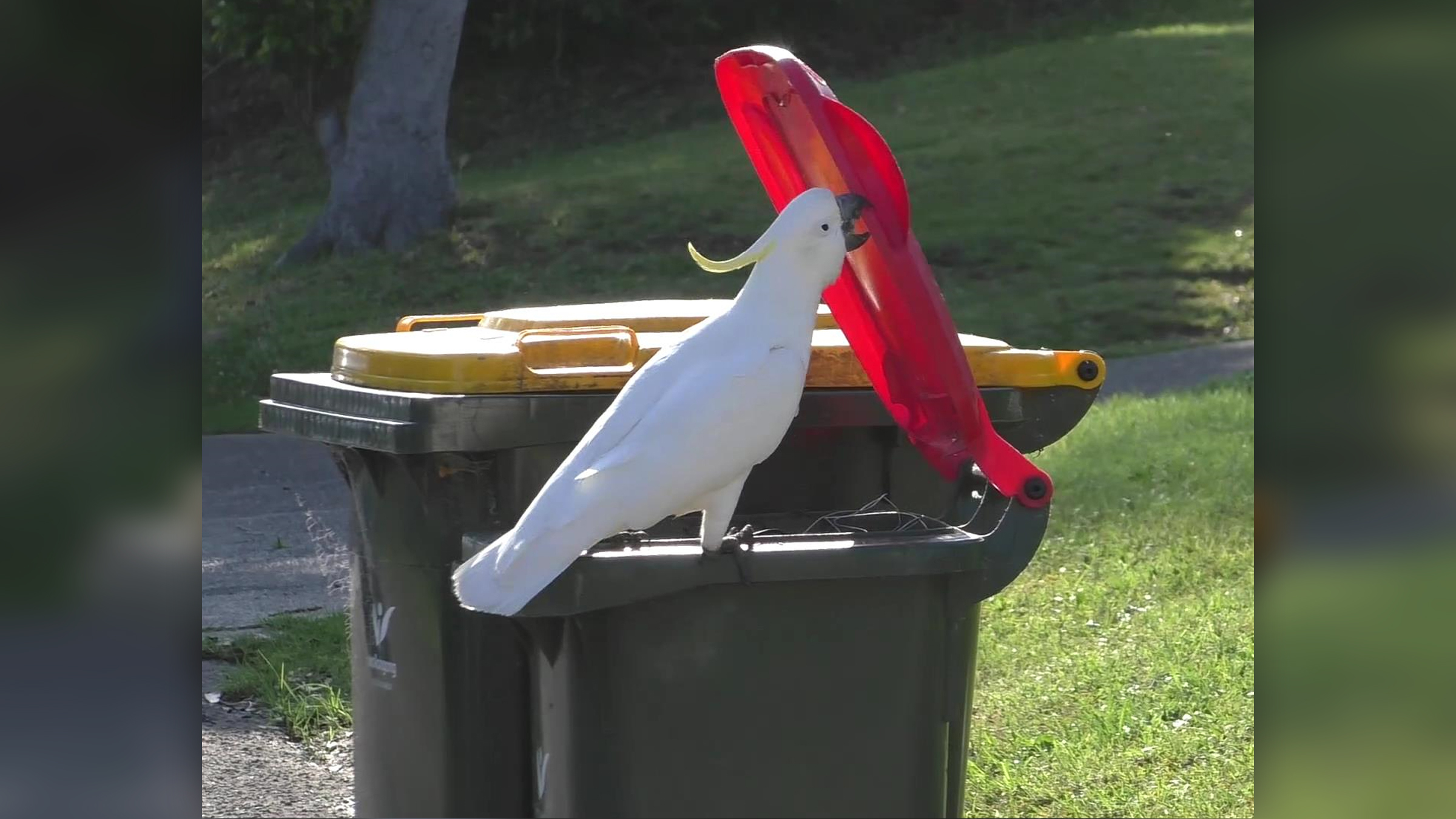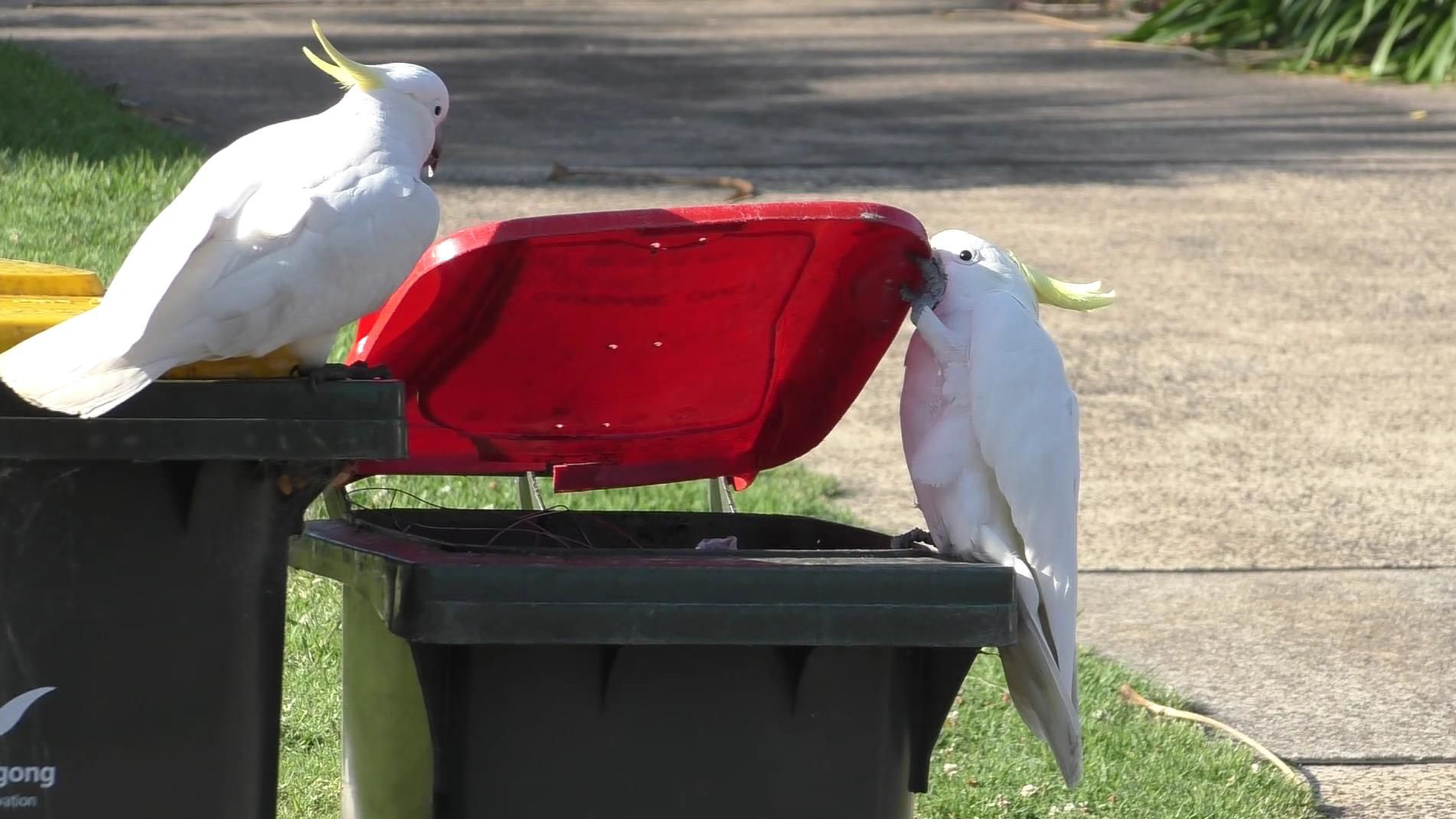'Trash parrots' in Australia have figured out how to open garbage cans (Video)
Social learning has helped cockatoos access trashy feasts.
Wild sulphur-crested cockatoos Down Under have learned how to open residential garbage-can lids and loot the leftovers, a new study finds. And apparently, the birds are learning this trick from one another.
One bird in a far-flung neighborhood even invented another lid-opening technique, which quickly spread to cockatoos in nearby suburbs.
"We observed that the birds do not open the garbage bins in the same way, but rather used different opening techniques in different suburbs, suggesting that the behavior is learned by observing others," study lead researcher Barbara Klump, a postdoctoral research fellow at the Max Planck Institute of Animal Behavior in Radolfzell, Germany, said in a statement.
Related: The 10 strangest animal stories of 2019
Sulphur-crested cockatoos (Cacatua galerita), natives of eastern Australia, are large-brained, long-lived and highly social parrots, the researchers said. A few years ago, study co-researcher Richard Major, a senior principal research scientist at the Australian Museum Research Institute who studies urbanization's effects on birds, showed a friend a video of a cockatoo opening a residential garbage-can lid. In the video, the cockatoo opens the lid with its beak and foot and then shuffles to the side to flip over the lid and access a garbage buffet.
Major's friend, study senior author Lucy Aplin, a research group leader at the Max Planck Institute of Animal Behavior, marveled at the bird's behavior, and so did Klump. "It was so exciting to observe such an ingenious and innovative way to access a food resource; we knew immediately that we had to systematically study this unique foraging behavior," Klump said.

The team wondered whether the birds had mastered this trash-can-opening behavior through social learning or genetics, so they enlisted the public's help. During an online survey in 2018 and 2019, the scientists asked Sydney- and Wollongong-area residents to document when and where they observed cockatoos opening household garbage cans.
Sign up for the Live Science daily newsletter now
Get the world’s most fascinating discoveries delivered straight to your inbox.
"Australian garbage bins have a uniform design across the country, and sulphur-crested cockatoos are common across the entire east coast," study co-researcher John Martin, a research scientist at the Taronga Conservation Society, said in the statement. "The first thing we wanted to find out is if cockatoos open bins everywhere."
The team received 338 reports from 44 suburbs describing cockatoos opening garbage cans. In 93% of those reports, multiple cockatoos were observed, "highlighting the ample opportunities for birds to observe bin opening," the researchers wrote in the study.

A map-based analysis revealed that the practice likely began in three suburbs in Sydney where people remembered seeing the practice before 2018. Once a cockatoo began opening garbage-can lids, the practice spread faster to cockatoos in neighboring areas than to those in faraway districts, suggesting that the behavior was socially learned.
"These results show the animals really learned the behavior from other cockatoos in their vicinity," Klump said.
Next, the researchers marked cockatoos with dots of paint in three bin-opening hotspots identified by the online survey. At one spot, Stanwell Park in Wollongong, New South Wales, of 114 birds marked, 36 birds tried to open the bins, but only nine were successful. Both juveniles and adults opened the bins, and most of the birds who tried to open the bins were male, the researchers found. The other birds waited until the heavy lifting was done before joining the flock at the garbage feast.
It's unknown why males were more likely than females to open the trash cans, but male cockatoos tend to be heavier and more dominant, and they may be stronger than females, the researchers noted. Or, perhaps the males were more aggressive in "claiming" the bin, as the researchers frequently saw cockatoos displacing their fellows off the trash cans.
Video footage of the cockatoos also revealed that opening garbage-can lids is a complex, multistep process that can be done in different ways. It appears that in different neighborhoods, there are different subcultures for how these birds open the lids, which is further evidence that this behavior is learned, not genetic, the researchers said.
The study was published online Thursday (July 22) in the journal Science.
Originally published on Live Science.

Laura is the archaeology and Life's Little Mysteries editor at Live Science. She also reports on general science, including paleontology. Her work has appeared in The New York Times, Scholastic, Popular Science and Spectrum, a site on autism research. She has won multiple awards from the Society of Professional Journalists and the Washington Newspaper Publishers Association for her reporting at a weekly newspaper near Seattle. Laura holds a bachelor's degree in English literature and psychology from Washington University in St. Louis and a master's degree in science writing from NYU.









